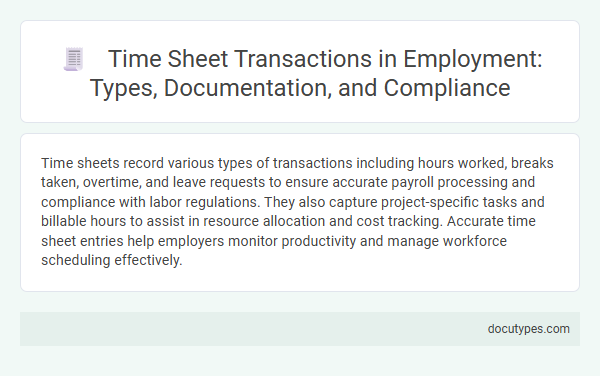Time sheets record various types of transactions including hours worked, breaks taken, overtime, and leave requests to ensure accurate payroll processing and compliance with labor regulations. They also capture project-specific tasks and billable hours to assist in resource allocation and cost tracking. Accurate time sheet entries help employers monitor productivity and manage workforce scheduling effectively.
Introduction to Time Sheet Transactions in Employment
Time sheets are essential tools in employment, capturing various types of transactions related to work hours. These records help ensure accurate tracking of employee attendance, payroll, and project management.
Time sheet transactions typically include clock-in and clock-out times, breaks, and overtime hours. Your employer uses this data to calculate wages, monitor productivity, and comply with labor regulations. Accurate time sheet entries contribute to transparent communication between employees and management.
Importance of Accurate Time Tracking
Time sheets record various types of work-related transactions essential for organizational efficiency. Accurate time tracking ensures proper payroll processing and project management.
Precise recording of hours worked enables fair compensation and compliance with labor laws.
Detailed task entries in time sheets facilitate performance analysis and resource allocation.
- Billable Hours - Tracks hours worked on client projects to generate accurate invoices and revenue reports.
- Overtime Transactions - Records extra hours worked beyond regular schedules to calculate additional pay and ensure legal compliance.
- Leave and Absences - Logs vacation, sick leave, and other time off to manage workforce availability and maintain accurate attendance records.
Types of Time Sheet Transactions
| Type of Transaction | Description | Examples |
|---|---|---|
| Regular Hours | Standard working hours completed by an employee during a pay period. | Monday to Friday, 9 AM to 5 PM shifts |
| Overtime Hours | Hours worked beyond the employee's standard schedule, often compensated at a higher pay rate. | Work beyond 40 hours per week |
| Breaks and Meal Periods | Periods during the workday when the employee is not performing work-related tasks. | Lunch break, coffee breaks |
| Paid Time Off (PTO) | Authorized leave during which the employee is paid, including vacation and personal days. | Vacation leave, personal days, paid holidays |
| Sick Leave | Time recorded when an employee is absent due to illness or medical appointments. | Flu sick days, medical appointments |
| Leave of Absence | Extended time away from work for specific reasons, either paid or unpaid. | Parental leave, military leave, unpaid leave |
| Training and Development | Hours spent attending training sessions or professional development activities. | Workshops, certification courses |
| Project-Specific Time | Time allocated to tasks or projects, useful for client billing or project accounting. | Consulting hours, client presentations |
Manual vs. Digital Time Sheet Systems
What types of transactions are recorded in time sheets? Time sheets capture employee work hours, break periods, overtime, and task-specific activities. Manual systems rely on handwritten entries, while digital systems automatically log time through software or biometric devices.
Key Documentation Requirements
Time sheets document various transactions such as hours worked, overtime, and break periods to ensure accurate payroll processing. They also record project codes and task descriptions to allocate labor costs correctly.
Key documentation requirements include precise timestamps, employee identification, and supervisor approvals for verification. Maintaining detailed records supports compliance with labor regulations and simplifies audit processes.
Common Errors and How to Avoid Them
Time sheets record various types of employment transactions such as hours worked, breaks taken, overtime, and leave periods. Accurate entries ensure proper payroll processing and compliance with labor regulations.
Common errors include incorrect time entries, missing breaks, and unapproved overtime which can lead to payroll disputes and legal issues. Ensuring employees understand time tracking policies and using automated time management systems helps prevent these mistakes.
Legal and Regulatory Compliance
Time sheets record employee work hours, breaks, and overtime to ensure accurate payroll processing and compliance with labor laws. These records serve as legal evidence in disputes related to wage and hour regulations, including the Fair Labor Standards Act (FLSA). Maintaining precise time sheet data helps organizations meet regulatory requirements and avoid penalties from labor authorities.
Employer and Employee Responsibilities
Time sheets record transactions such as hours worked, breaks taken, and overtime. Employers use this data to ensure accurate payroll processing and labor compliance. Employees have the responsibility to submit time sheets honestly and promptly to reflect their actual work hours.
Impact on Payroll and Benefits
Time sheets capture various work-related transactions critical for accurate payroll processing and benefits administration. Recording precise work hours ensures employees receive proper compensation and entitlement to benefits based on their logged time.
- Regular hours - Document standard work hours that determine basic salary calculations and eligibility for standard benefits.
- Overtime hours - Track hours worked beyond regular shifts, impacting overtime pay rates and additional compensation benefits.
- Leave and absences - Record paid or unpaid leave which affects payroll deductions and accrual of benefits such as vacation or sick time.
What Types of Transactions Are Recorded in Time Sheets? Infographic

